Hemiparesis, also called unilateral paresis, is the weakness of one entire side of the body. Hemiplegia, in its most severe form, is the complete paralysis of one entire side of the body. Either hemiparesis or hemiplegia can result from a variety of medical causes, including congenital conditions, trauma, tumors, traumatic brain injury and stroke.

Cerebral palsy (CP) is a group of movement disorders that appear in early childhood. Signs and symptoms vary among people and over time, but include poor coordination, stiff muscles, weak muscles, and tremors. There may be problems with sensation, vision, hearing, and speech. Often, babies with cerebral palsy do not roll over, sit, crawl or walk as early as other children. Other symptoms may include seizures and problems with thinking or reasoning. While symptoms may get more noticeable over the first years of life, underlying problems do not worsen over time.
Rehabilitation of sensory and cognitive function typically involves methods for retraining neural pathways or training new neural pathways to regain or improve neurocognitive functioning that have been diminished by disease or trauma. The main objective outcome for rehabilitation is to assist in regaining physical abilities and improving performance. Three common neuropsychological problems treatable with rehabilitation are attention deficit/hyperactivity disorder (ADHD), concussion, and spinal cord injury. Rehabilitation research and practices are a fertile area for clinical neuropsychologists, rehabilitation psychologists, and others.
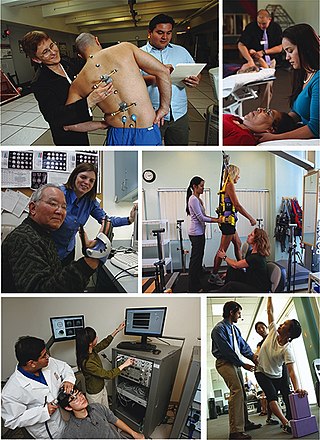
Kinesiology is the scientific study of human body movement. Kinesiology addresses physiological, anatomical, biomechanical, pathological, neuropsychological principles and mechanisms of movement. Applications of kinesiology to human health include biomechanics and orthopedics; strength and conditioning; sport psychology; motor control; skill acquisition and motor learning; methods of rehabilitation, such as physical and occupational therapy; and sport and exercise physiology. Studies of human and animal motion include measures from motion tracking systems, electrophysiology of muscle and brain activity, various methods for monitoring physiological function, and other behavioral and cognitive research techniques.
The primary goals of stroke management are to reduce brain injury and promote maximum patient recovery. Rapid detection and appropriate emergency medical care are essential for optimizing health outcomes. When available, patients are admitted to an acute stroke unit for treatment. These units specialize in providing medical and surgical care aimed at stabilizing the patient's medical status. Standardized assessments are also performed to aid in the development of an appropriate care plan. Current research suggests that stroke units may be effective in reducing in-hospital fatality rates and the length of hospital stays.
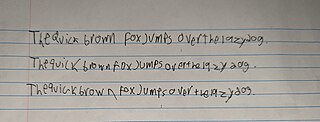
Dysgraphia is a neurological disorder and learning disability that concerns impairments in written expression, which affects the ability to write, primarily handwriting, but also coherence. It is a specific learning disability (SLD) as well as a transcription disability, meaning that it is a writing disorder associated with impaired handwriting, orthographic coding and finger sequencing. It often overlaps with other learning disabilities and neurodevelopmental disorders such as speech impairment, attention deficit hyperactivity disorder (ADHD) or developmental coordination disorder (DCD).
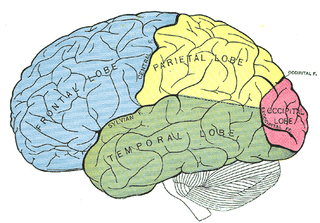
Bálint's syndrome is an uncommon and incompletely understood triad of severe neuropsychological impairments: inability to perceive the visual field as a whole (simultanagnosia), difficulty in fixating the eyes, and inability to move the hand to a specific object by using vision. It was named in 1909 for the Austro-Hungarian neurologist and psychiatrist Rezső Bálint who first identified it.
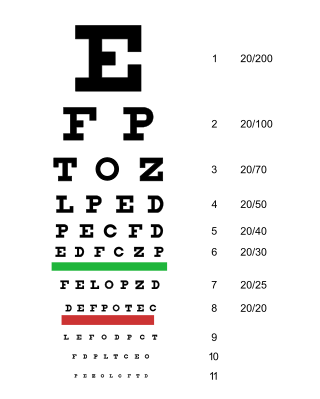
Visual or vision impairment is the partial or total inability of visual perception. In the absence of treatment such as corrective eyewear, assistive devices, and medical treatment, visual impairment may cause the individual difficulties with normal daily tasks, including reading and walking. The terms low vision and blindness are often used for levels of impairment which are difficult or impossible to correct and significantly impact daily life. In addition to the various permanent conditions, fleeting temporary vision impairment, amaurosis fugax, may occur, and may indicate serious medical problems.
Dysmetria is a lack of coordination of movement typified by the undershoot or overshoot of intended position with the hand, arm, leg, or eye. It is a type of ataxia. It can also include an inability to judge distance or scale.
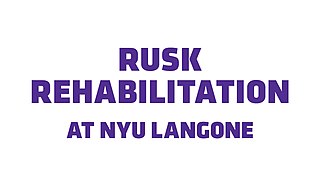
Rusk Rehabilitation is the world's first and among the largest university-affiliated academic centers devoted entirely to inpatient/outpatient care, research, and training in rehabilitation medicine for both adults and pediatric patients. The system is part of the NYU Langone Medical Center and operated under the auspices of the Department of Rehabilitation Medicine of the New York University School of Medicine. The Rusk Institute is named in honor of its founder, Howard A. Rusk.

The Shirley Ryan AbilityLab, formerly the Rehabilitation Institute of Chicago (RIC), is a not-for-profit physical medicine and rehabilitation research hospital based in Chicago, Illinois. Founded in 1954, the AbilityLab is designed for patient care, education, and research in physical medicine and rehabilitation (PM&R). The AbilityLab specializes in rehabilitation for adults and children with the most severe, complex conditions ranging from traumatic brain and spinal cord injury to stroke, amputation and cancer-related impairment. Affiliated with Northwestern University, the hospital is located on Northwestern’s Chicago campus and partners on research and medical efforts.
Virtual reality in telerehabilitation is a method used first in the training of musculoskeletal patients using asynchronous patient data uploading, and an internet video link. Subsequently, therapists using virtual reality-based telerehabilitation prescribe exercise routines via the web which are then accessed and executed by patients through a web browser. Therapists then monitor the patient's progress via the web and modify the therapy asynchronously without real-time interaction or training.
Hand–eye coordination is the coordinated motor control of eye movement with hand movement and the processing of visual input to guide reaching and grasping along with the use of proprioception of the hands to guide the eyes, a modality of multisensory integration. Eye–hand coordination has been studied in activities as diverse as the movement of solid objects such as wooden blocks, archery, sporting performance, music reading, computer gaming, copy-typing, and even tea-making. It is part of the mechanisms of performing everyday tasks; in its absence, most people would not be able to carry out even the simplest of actions such as picking up a book from a table.

Howard A. Rusk was a prominent American physician and founder of the Rusk Institute of Rehabilitation Medicine. He is considered to be the founder of rehabilitation medicine.

NYU Langone Health is an integrated academic health system located in New York City, New York, United States. The health system consists of the NYU Grossman School of Medicine and NYU Grossman Long Island School of Medicine, both part of New York University (NYU), and more than 300 locations throughout the New York City Region and Florida, including six inpatient facilities: Tisch Hospital; Kimmel Pavilion; NYU Langone Orthopedic Hospital; Hassenfeld Children's Hospital; NYU Langone Hospital–Brooklyn; and NYU Langone Hospital–Long Island. It is also home to Rusk Rehabilitation. NYU Langone Health is one of the largest healthcare systems in the Northeast, with more than 52,000 employees.

Neurological disorders represent a complex array of medical conditions that fundamentally disrupt the functioning of the nervous system. These disorders affect the brain, spinal cord, and nerve networks, presenting unique diagnosis, treatment, and patient care challenges. At their core, they represent disruptions to the intricate communication systems within the nervous system, stemming from genetic predispositions, environmental factors, infections, structural abnormalities, or degenerative processes.
Steven R. Flanagan is a nationally renowned expert in the field of traumatic brain injury (TBI) and is professor and chairman of the Department of Rehabilitation Medicine at the New York University School of Medicine, and the medical director of the Rusk Institute of Rehabilitation Medicine at the NYU Langone Medical Center.

The Center for Neurotechnology (CNT) is an Engineering Research Center funded by the National Science Foundation, develops devices to restore the body's capabilities for sensation and movement. The center is based at the University of Washington. Its core partner organizations are the Massachusetts Institute of Technology and San Diego State University.
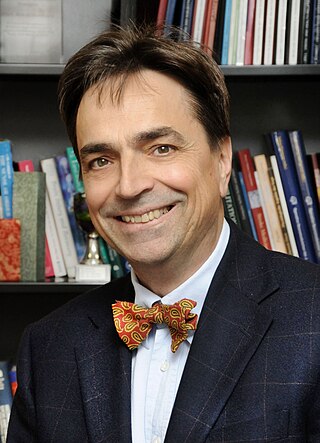
Bernhard Sabel is a German neuropsychologist and brain researcher. His more than 40 years of research are documented in over 200 publications, investigating treatment options for visual impairments through the activation and rehabilitation of residual vision capabilities.
Laura Joan Balcer is an American neuro-ophthalmologist who is the vice chair of the neurology department at the New York University Grossman School of Medicine.












